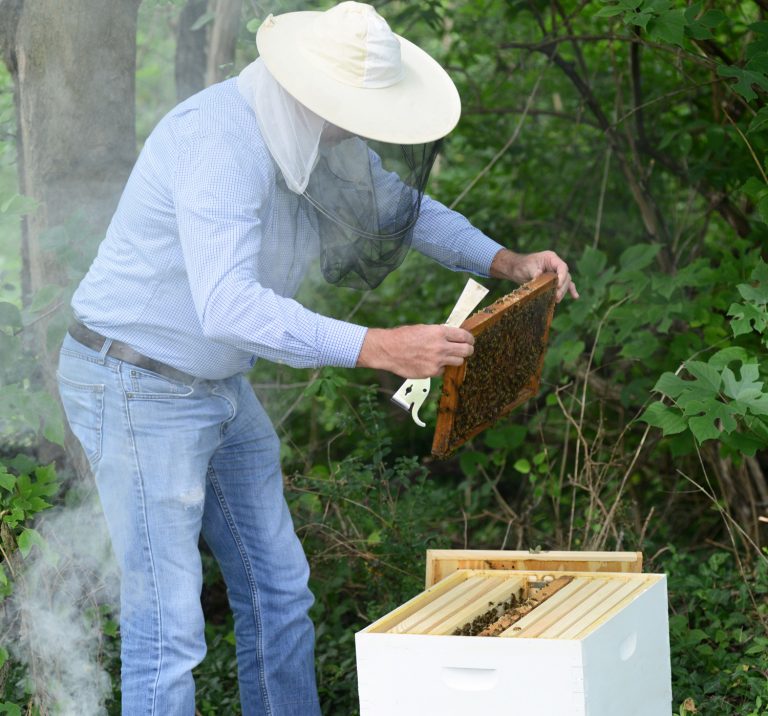It’s not easy being a bee.
You’ve likely heard about the plight of pollinators over the last decade. Honeybees in particular have suffered alarming population declines because of a variety of factors, chief among them loss of habitat and the use of pesticides. So, in an effort to do our part to help these important insects, this past summer Tennessee Wildlife Federation installed a beehive behind our office.
Despite our good intentions, things didn’t go as planned. What happened, you ask? Well, the short answer is that we may never know for sure.
The Federation took on this project with the help of its administration manager, Tony Lance. He’s been keeping bees since he was a kid and, along with a friend, has a small beekeeping operation about 30 miles north of Nashville in a relatively rural setting. In other words, he’s not a newbie when it comes to beekeeping.
When the Federation set the hive up, everything appeared to be progressing as expected. The bees were foraging well, bringing in pollen and nectar, and they were producing new comb that the queen dutifully filled with eggs. When we looked in on them after two weeks there was plenty of larvae and capped brood—or, larvae that has matured into pupae. The population of the hive was growing normally.
About a month in, as Tony was refilling the bees’ feeder jar, he noticed dozens of larvae on the ground in front of the hive. While it’s not unheard of for bees to remove larvae, often in response to disease or to unseasonably cold temperatures, seeing so many was alarming.
It warranted an inspection.
He opened up the hive to take a closer look. What he saw was something he’d never before seen: all of the larvae and pupae had been removed and the cells that housed them had been chewed down to their foundations. Something had happened that was so severe that it had either killed all the developing bees or it had caused the bees to kill them.
He looked for signs of disease. Finding none, he sent an email to both the state beekeeper and the state apiarist detailing what happened. Neither of them had heard of anything quite like what we were witnessing.
We decided to take a wait-and-see approach and see how the bees responded over the next couple of weeks. The signs were encouraging. The queen promptly began laying again and the workers rebuilt the comb they’d torn down. When we inspected them two weeks later they appeared to be back on track with plenty of larvae and pupae present.
And then it happened again.
As Tony was preparing to feed them, he again saw dozens of larvae on the ground in front of the hive. A quick inspection revealed the same scenario: all of the developing bees had been removed and the comb they were in had been chewed away.
This occurrence was concerning enough for Tennessee’s state beekeeper to come inspect the hive to make certain that some contagion wasn’t causing the problem. He found no signs of disease and, like Tony, had never seen anything quite like this.
We thought about the possible causes. Our best guess was that the bees were foraging on landscaping plants that were treated with a systemic pesticide—a type of pesticide that gets into every cell of a treated plant. The pollen they were bringing in was killing the developing bees.
But, there’s no easy way to test this hypothesis. What’s more, if it was true, then it was likely that the bees would continue to be plagued by this problem if the hive stayed here. The bees would never have new, young bees the hive needs to grow and survive.
Our only alternative was to move the hive to a new location. So on a warm summer evening Tony transported the hive to his house and placed it alongside his own hives.
Then the final blow occurred.
The next day the established hives, sensing the weak condition of the new one, invaded and cleaned out their scant stores of honey, killing or driving away the weaker bees in the process. This behavior is simply known as “robbing.” Bees can be ruthless that way.
The takeaway from this ill-fated effort is that honeybees (and pollinators in general) often have a tough time thriving in the environment that humans have created. Starting a hive is one way we can help pollinators in a small way. But even with experience, it’s not a guaranteed success.




